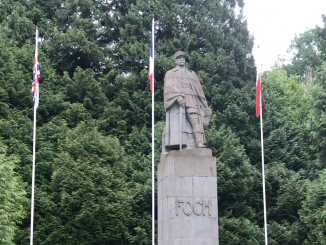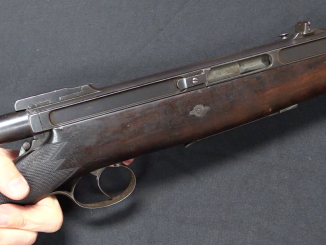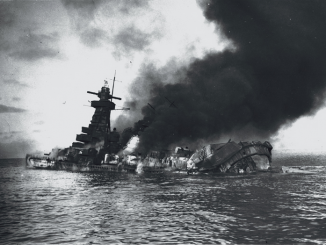Developed by Heinrich Vollmer in the 1920s, this quite distinctive submachine guns was marketed by the Erma company starting in 1932 and sold quite well internationally. This particular example was used by the German police and is chambered for 9x19mm. Many of these guns were also sold to Spain where they were popular with the Republican forces in the Spanish Civil War. At the end of that conflict, some 3,250 EMPs were surrendered to French border guards by Spanish Republican refugees coming over the Pyrenees. Many of these were issued out to French forces during the Battle of France.
Anyway, the main focus of today’s video is to show the differences between the original German Erma-produced guns and the Spanish MP41/44 copy made at La Coruña.




One of the most facinating aspects of French WW2 small arms There has been several articles on the difference between the German and spanish versions in Cibles and in Gazette des Armes For may 2020 there
is a story about one of these guns found at Forbach. The story by Olivier Bellac speculates that the gun a spanish version of the Vollmer probably used by french assault groups in
1940 had been taken apart so as not to fall into german hands
A further article by Bellac says the French got 3250 vollmers from republican forces but only 1540 clips.. During the winter of 1939-1940 300 of these guns were given to the french assault groups in Lorraine and others were given to the troops in may 1940
Yes, the corps francs or infiltration/scout troops in ’40 needed “mitraillettes” so the ex- Popular Army of the Spanish Republic SMGs were issued out. The Vollmer ERMA gun was relatively widely used in the Spanish Civil War, and in fact it became the basis for the army of the victorious Spanish State’s first SMG, the Model 1942. There were also many copies of the Schmeisser MP.28,II as well that became the “naranjero” variants in Spain, and were similarly used by French forces ahead of June 1940. The jury is still out about whether the MP.28,II used by the British to draw up the Lanchester was a bonafide Belgian or German version or a Spanish copy… A copy of a copy.
Elbonia had at least 200 of these. They were rebarreled to 7.62×25, and used PPSh drum mags.
The one thing I wanted to know, but the video did not clarify, is if the “police safety” functions when the bolt is pulled back as well? Sure, you can have too many safeties this way, but now I just have to know!
“is if the “police safety” functions when the bolt is pulled back as well?”(C)
Most likely, it works “separately”, providing only the function for which it was intended.
Judging by the fact that there was no front safety on the emp36 yet, and by the stupid screws, this is a later addition (which was not in the initial project), introduced (not in vain) at the request of users.
However, Ian said so.
It doesn’t seem like a perfect solution.
Sure these screws could be loose and the added safety was malfunctioning.
From here it should be clear.
https://www.youtube.com/watch?v=AxObwYbXUik
The article that I mentioned before says that the belgian firm Pieper sold 1000 licenced copies of the Schmeisser MP28/2
to the french army in april of 1940
It also says that 50 of the 300 suomi M31 guns taken off the republicans 50 were sent to the french army
I think most people have seen the pictures of the republicans surrendering their
weapons to the french at the border but I wonder if a number were not hidden or buried before the border. It might make an interesting metal detecting trip
They were offered for sale in virtually all / any caliber you could possibly want – so presumably the action capable of handling / adaptable to them. Not being an ammunition expert, how do the 9 mm Parabellum and the US .45 ACP (both of which widely used as SMG rounds) compare in their effects on this and other SMGs?
I can’t find a reference in the Versailles Treaty that outlawed sub-machine guns. Does anybody know where that is?
Maybe its a myth ??
It was a light machine gun. Light machine guns were restricted.
I’d call BAR light machine gun, but submachine gun never.
German disarmament, based on the Versailles treaty, was managed down to the details by the International Military Control Commission.
For example, on 12th March 1920 it determined:
– per policeman, one pistol and one bajonet is allowed,
– one third of all policemen may have a rifle or a carbine,
– one submachine-gun per 20 policemen is allowed.
All other weapons, in particular machine guns, were declared illegal for German police by IMKK, because they were not required to establish public order.
It’s interesting that in the post WWI period, political militias were sometimes in the position of being better equipped than the state was.
What are the examples for that weird statement ?
The Freikorps? e.g. the proto-fascists?
My understanding is that in Italy some 57% of squadristi were WWI vets. In Germany, I think you’ll find similar numbers during the suppression of the revolutionary left from the Spartakisten, the München räterepublik, the Ruhrkrieg, und so weiter:
https://de.wikipedia.org/wiki/Kategorie:Paramilit%C3%A4rische_Organisation_(Weimarer_Republik)
As for the Versailles treaty, the enforcement even called for the removal of the Artillery model Luger P08s, unless I’m mistaken…
Ok, but I would not say these obscure quasi-militias were better equipped than the official army, I do not even think that on paper legally could they even bear arms.
@super390
This duPont is new to me, I find it very interesting, right now at the time I’m too burned out for another wikipedia learning session 🙂 but will check it out sometime
Perhaps you might profitably study the war after WWI? Armored cars, water cooled machine guns, rifles, hand grenades, mortars, grenade launchers, even some artillery… The Baltic States, Poland, Silesia, Prussia, the Romanian invasion of Hungary, the breakup of the Austro-Hungarian corpse formerly shackled to the German Empire, etc. etc. the “Red Years and Black Years” in Italy, the “triennio Bolshevique” in Spain, the Greco-Turkish War and ethnic cleansing of Anatolia and the Balkans, one can go on for a while. Who ever said anything about “legality” anyway?
Also, the SA Brownshirt militia supposedly reached 4 million members at a time when the Reichswehr was limited to 100,000, but I expect the only time its actual arsenal could have exceeded the Reichswehr was after Hitler came to power and before the SA was crushed in the Night of the Long Knives. Since Germany was still short of weapons 5 years later, I’d guess the Brownshirts stuck to pistols and fists.
Interestingly, there was a plot afoot to create a fascist militia in the USA that would outnumber the US Army (then 80,000 men). This was the DuPont conspiracy of 1934, in which unemployed veterans would be recruited for a militia secretly run by anti-Roosevelt billionaires, but to be publicly headed by Smedley Butler. Instead, he collected information and then exposed them. The weapons side of this would have been an interesting project given the terrible condition of the US Army, the exotic weapons held by some police forces, and the global arms trade of the time. There had to be plenty of bankrupt governments willing to part with their heavier weapons to the highest bidder.
Perhaps the inspirational guns for the Lanchester are still in the pattern room collection?
That’d be neat! Supposedly one of the M.P.28,IIs made in Belgium under license, but then again, it seems clear that the use of the brass magazine housing as a simpler-to-manufacture cast unit came from the Spanish naranjero of ex-SCW origin. Oddly, it would seem most of the EMPs from the second republic of Spain to France were 9mm Parabellum, while most of the MP28s were 9mm Largo?
Is it just me, or there isnt Erma shooting video article on this official f.w. page?
On youtube account there is a video, maybe its some kind of error…
It seems to me that Ian is in vain ignoring the design features of the models. After all, the main differences, are not in the names and brands, but in the design.
Thanks to this, in fact, new names appeared.
For example, what are the differences between the MP18 and MP28 ignition systems?
Or MP28 and EMP?
And there are differences, and they are fundamental.
Or feed systems. Why did the idiotically unreliable MP38 mags appear, when there were already quite good EMP mags?..
Ian, the cartridge the Spanish guns are chamber for is the 9 mm Largo (primo voto 9 mm Bergmann No.6) and NOT 9 mm Steyr. Not all 9x23s are 9 mm Steyr – the .38 ACP is also in 23 mm long cases, as well as .38 Super. The difference between 9 Steyr and 9 Largo lays mostly in the shape of the case (more conical in 9S, more cylindrical in 9L)